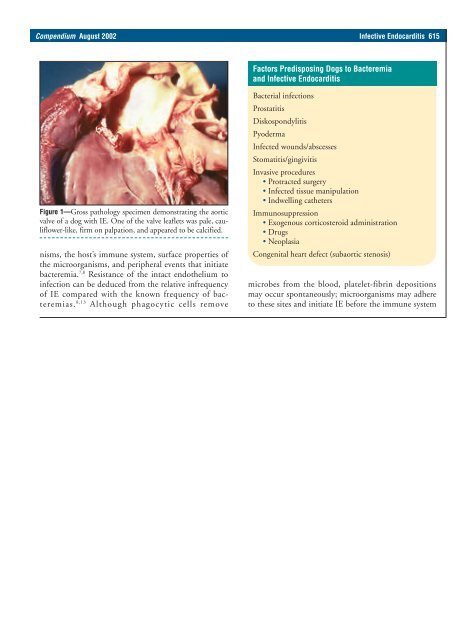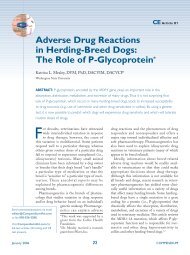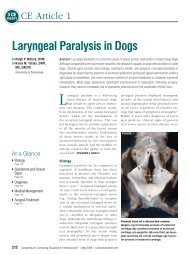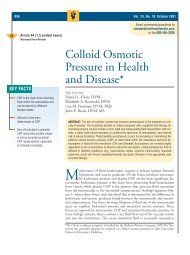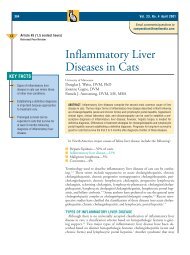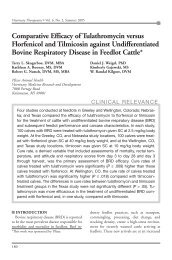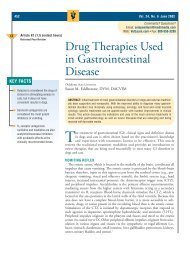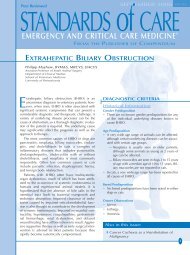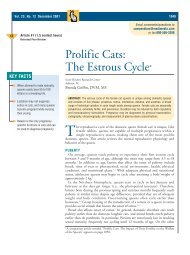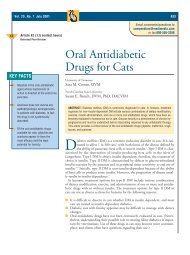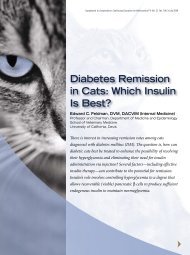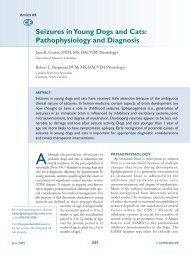Compendium August 2002 Infective Endocarditis 615 Figure 1—Gross pathology specimen demonstrating the aortic valve of a dog with IE. One of the valve leaflets was pale, cauliflower-like, firm on palpation, and appeared to be calcified. nisms, the host’s immune system, surface properties of the microorganisms, and peripheral events that initiate bacteremia. 7,8 Resistance of the intact endothelium to infection can be deduced from the relative infrequency of IE <strong>com</strong>pared with the known frequency of bacteremias. 8,13 Although phagocytic cells remove Factors Predisposing Dogs to Bacteremia and Infective Endocarditis Bacterial infections Prostatitis Diskospondylitis Pyoderma Infected wounds/abscesses Stomatitis/gingivitis Invasive procedures • Protracted surgery • Infected tissue manipulation • Indwelling catheters Immunosuppression • Exogenous corticosteroid administration • Drugs • Neoplasia Congenital heart defect (subaortic stenosis) microbes from the blood, platelet-fibrin depositions may occur spontaneously; microorganisms may adhere to these sites and initiate IE before the immune system
616 Small Animal/Exotics Compendium August 2002 can obliterate the infection. 8 Chronic, low-grade microbemia predisposes dogs to IE. 7,13,14 Infective microorganisms in the blood must be capable of adhering to a platelet-fibrin matrix. 7,8,15 Within this matrix, not only are white blood cells unable to phagocytize bacteria, but the bacteria are very concentrated. 7,8,15 Very few granulocytes are within the vegetation; and layers of fibrin, platelets, and RBCs protect the microorganisms. 7,8 VALVE INVOLVEMENT Heart valves are subject to constant trauma as they open and close. 7,8 The incidence of IE appears to be directly related to the force placed upon each valve. 16,17 The mitral and aortic valves are most <strong>com</strong>monly infected, and the tricuspid and pulmonic valves are seldom involved. 2,4,6,9–16,18,19 In a study of 45 dogs, 22 had aortic involvement, 16 had mitral, 1 had both aortic and mitral, and only 1 had tricuspid involvement. 6 During the past 10 years, our experience is that approximately 90% of infections involve the aortic valve. EPIZOOTIOLOGY The prevalence of IE is much lower than that of dilated cardiomyopathy and myxomatous mitral valve degeneration. The incidence rates at two referral institutions were both approximately five cases per year. 6,10 During the last 10 years, two to five dogs with IE have been recognized annually at the University of Georgia. Typically, affected dogs are 4 to 8 years of age and medium to large sized (less than 10% weigh less than 10 kg). 6,10 Affected dogs are seldom younger than 2 or older than 10 years of age. German shepherds, boxers, golden retrievers, Labrador retrievers, and rottweilers may be overrepresented. 1–4,6,9–11 Males are affected more often; a 2:1 ratio, possibly due to chronic bacterial prostatitis, has been reported. 6 PREDISPOSING FACTORS There are numerous factors predisposing dogs to the development of IE. A <strong>com</strong>mon misconception is that IE is associated with structural heart disease. It is interesting that dogs with the highest incidence of advanced myxomatous mitral valve degeneration (older, smallbreed dogs) have a very low incidence of IE. Furthermore, IE is seldom associated with congenital heart diseases in dogs, with the exception of subvalvular aortic stenosis (SAS). 1–4,6,19 With SAS, turbulent, high-velocity blood flow in the left heart may produce microtrauma on the valve leaflets and facilitate microbe colonization. 9,10,19,20 Boxers, rottweilers, and golden retrievers have relatively high incidences of both IE and SAS. 2,3,6,19,20 Less than 10% of dogs with SAS develop IE, www.<strong>VetLearn</strong>.<strong>com</strong> and possibly less than 10% of dogs with IE have SAS. 2,3,6,19,20 Establishing or eliminating an ultrasonographic diagnosis of SAS with aortic valve IE can be difficult because the vegetation may obscure the SAS lesion. Predisposing factors for platelet–fibrin–RBC deposition on the endocardium include procedures involving the gingiva, oropharynx, gastrointestinal tract, or infected tissues and intravenous (IV) catheters. 6,8,9,12,21–23 Although gingivitis/stomatitis may be associated with bacteremia and IE, dogs with the highest incidence of this condition (older, small-breed dogs) seldom develop IE. 2,3,6 Hypercoagulability associated with malignancies, disseminated intravascular coagulation, hypercortisolemia, or immune-mediated diseases may predispose dogs to IE. 7,8,24 Any abnormality that either is associated with chronic bacteremia (e.g., gingivitis, urinary or prostatic infection, pyoderma, wounds) or impairs host defenses (e.g., neoplasia, diabetes mellitus, hyperadrenocorticism, exogenous corticosteroids or other immunosuppressive therapies) increases the risk for IE. 5,8,12,13 However, dogs most prone to hyperadrenocorticism have a low incidence of IE, and we have rarely identified the two conditions in the same dog. The source of infection may be suspected but is proven in less than 50% of cases. 6,12,13 Damaged endothelium exposes the extracellular polysaccharide dextran, which facilitates the attachment of some bacterial species. 25,26 Because of the limited species of microbes that account for the vast majority of IE cases, it can be deduced that certain organisms (e.g., coagulase-positive staphylococci and some streptococci) have an increased ability to colonize the endocardium. 2,3,6–8,15 Fibronectin can be produced by endothelial cells and platelets in response to vascular injury, and receptors for fibronectin are present on the surface of some bacteria, including coagulase-positive staphylococci and some streptococci. 26 Fibronectin may even facilitate the adherence of some bacteria, including staphylococci, to intact endothelium. 15,26 Corticosteroids Dogs affected with IE often have a history of receiving corticosteroids. 6 In some instances, corticosteroids were administered in the weeks preceding the development of IE to treat an illness associated with unrecognized bacteremia, skin disease, or presumed immunemediated disease. Survival rates of dogs with mitral valve IE that received corticosteroids were lower than those that did not receive them. 6 Infective Microbes The vast majority of IE cases are the result of bacteria; rickettsial agents are occasionally identified, but fungal


